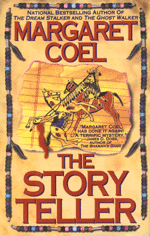


Winter's Child
Man Who Fell from Sky
Night of the White Buffalo
Killing Custer
Buffalo Bill's Dead Now
The Perfect Suspect
The Spider's Web
Silent Spirit
Blood Memory
Girl w/ Braided Hair
Drowning Man
Eye of the Wolf
Wife of Moon
Killing Raven
Shadow Dancer
Thunder Keeper
Spirit Woman
Lost Bird
Story Teller
Dream Stalker
Ghost Walker
Eagle Catcher







|
 |

 The Story Teller: An Interview with Margaret Coel
The Story Teller: An Interview with Margaret Coel
What was the idea that grew into a mystery novel about an Arapaho ledger book?
A couple of ideas. I wanted to set a novel mostly in Denver. It's a city I grew up in and know very well. I can find my way around with my eyes
closed. It also sprawls across land that once belonged to the Arapahos, so they have an affinity for the area. I wanted to bring some of their history
into the story. Although parts of the novel are set in the familiar surroundings of the Wind River Reservation, a large part takes place in Denver.
And, I wanted to tell the story mainly from Vicky's point of view. Rather, I wanted to give Vicky a chance to tell her own story. How she came to be a
lawyer in a one-woman office in Lander. How she came to be Hi sei cinihi. Woman Alone. I think the other novels touch upon her background, but
The Story Teller lets her speak up for herself.
I find the ledger book idea most intriguing. Tell us about the Plains Indian ledger books.
I find the ledger books intriguing, too, which is why I decided to plot the novel around one. Ledger books are simply account books kept by every
merchant and farmer in the 1800s. You've seen them, I'm sure. They're long and narrow, with gray-green covers, lined pages, and red vertical lines
along the sides. In about the 1840s, the Plains Indians—Sioux, Cheyenne, Kiowa, and Arapaho—began trading for these books and for crayons and
pencils. Then they wrote in the books. They "wrote" in highly detailed pictographs. At first the ledger books were valued by non-Indians as interesting drawings. But in the last twenty years, scholars have realized that these books contained accurate records of actual
events on the plains. In fact, the Plains Indians wrote the first histories of the plains.
Wow! Where can I find one of these books?
Most have been destroyed. Those that survived are in museums across the country. Some are worth about a million dollars. A lot of the books
were destroyed by artifact dealers who razored out the pages and sold them to collectors one by one. You can still find individual pages for sale in
upscale galleries in places like Santa Fe and Aspen. Be prepared to pay a very high price.
So a book worth a million dollars is just what you need for a mystery plot, right?
Absolutely! In The Story Teller, Vicky and Father John O'Malley are on the trail of an Arapaho ledger book that has disappeared from a
Denver museum. They must find it before it reaches the artifacts market—where the pages will be sold individually. The last person who found the
book has been murdered, and Vicky and Father John both know that the closer they come to the book, the more likely they are to become the next
victims.
Tell us about the relationship between Father John O'Malley and Vicky. How is it progressing?
You'll have to read The Story Teller to find out. I can tell you this, however. They find themselves in Denver—far from their usual
environment.
|

|

